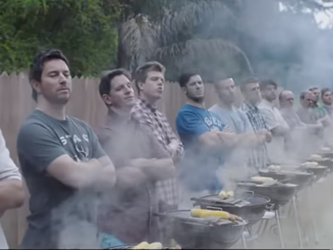Holding up a mirror
The beauty industry must be very pleased with itself at the moment. After years of trying to diversify, men are finally wearing makeup and the male grooming industry is now valued at $50bn globally.
L’Oréal’s UK managing director, Vismay Sharma, recently said it was no longer a taboo for men – as part of the “selfie generation” – to use cosmetics. He predicts that male-targeted makeup counters in chemists and department stores will be mainstream in the next five to seven years.
Regardless of whether or not you foresee a future for department stores in the next five to seven years, there is growing evidence that men in Britain take their appearance seriously. According to YouthSight’s tracker, the State of the Youth Nation, 61% of young men say they try to look their best before leaving the house – which is even more interesting when only 56% of young women say the same.
We wanted to find out whether young men wearing makeup was a real trend or just hype. As part of our youth insight tracker, we found that, in 2018, one in 10 young men aged 16 to 24 wears makeup.
A cursory look at Asos reveals the growing diversity of male grooming products on offer. Glancing at its ‘Face + Body’ page, you will see makeup products from the likes of Mac, NYX, Nars and Laura Mercier listed alongside brands such as Bulldog, American Crew and Johnny’s Chop Shop. Furthermore, UK brand MMUK (Men’s Make-up UK) claims that 40% of its customers are in their teens or twenties.
Of course, men in makeup isn’t a new thing. The pharaohs wore eyeliner, men in ancient Rome applied red pigment to their cheeks, and the Elizabethans wore ghost-white powder. It wasn’t until the 20th century that men wore makeup as a sign of rebellion – think David Bowie, Prince and Boy George.
Today, however, makeup is less about subcultures and rebellion, and more about YouTube transformations and gender experimentation.
While young men and women both wear makeup to feel good, we found that males are more likely to wear it to express themselves and their creativity. It appears that it is an emotional and creative outlet for young men.
Masculinity is polarised
The accepted mainstream has traditionally been positioned closest to hyper-masculinity, characterised by men with muscles, getting the girl and never showing weakness.
Masculinity is now polarised, however. From the rejection of ‘lad culture’ in the UK to the global #MeToo movement, many are calling mainstream masculinity toxic. Of course, not all men are hyper-masculine.
According to YouGov, only 2% of 18- to 24-year-old males identified as completely masculine when they were asked to rate themselves on a scale, compared with 56% of men aged 65 or over, suggesting a clear generational divide.
Mainstream culture does not accurately represent masculinity today. Although some young men in the UK wear
makeup, and some identify with hyper-masculinity, the vast majority sit somewhere in between.
As a society, we need to discover how masculinity can be good again, especially as people aged 18 to 24 are more likely to see it as a negative trait than a positive one (YouGov).
As brands have helped redefine what it means to be a woman, they also have permission to rewrite what it means to be a man.
One place to start looking for solutions is fourth-wave feminism and its story of empowerment. You can be who you want to be, accept that people come in all shapes and sizes, and traditional gender stereotypes no longer apply to the modern world. These ideals are as relevant to young men as young women.
Brands should recognise that there is a sliding scale of masculinity – and that the majority of young men sit somewhere in the middle – and use their voices to make the middle more acceptable, comfortable and real.
They could also go one step further and think about uniting men around something other than masculinity, such as Bud Light’s ‘Please enjoy responsibly’ ad, which used humour to mock modern life and succeeded in making a low-alcohol beer relevant to young people.
The stage is set for masculinity to get a makeover. I hope you are inspired to be part of the solution.
Josephine Hansom is managing director of insight at YouthSight.
YouthSight interviews 1,000 16- to 24-year-olds every 60 days as part of its State of the Youth Nation tracker.
This article was first published in Issue 24 of Impact.

We hope you enjoyed this article.
Research Live is published by MRS.
The Market Research Society (MRS) exists to promote and protect the research sector, showcasing how research delivers impact for businesses and government.
Members of MRS enjoy many benefits including tailoured policy guidance, discounts on training and conferences, and access to member-only content.
For example, there's an archive of winning case studies from over a decade of MRS Awards.
Find out more about the benefits of joining MRS here.












0 Comments